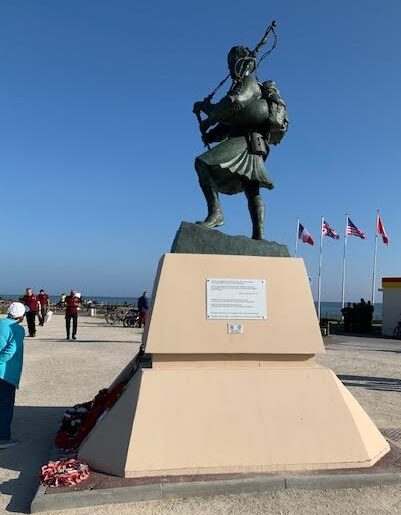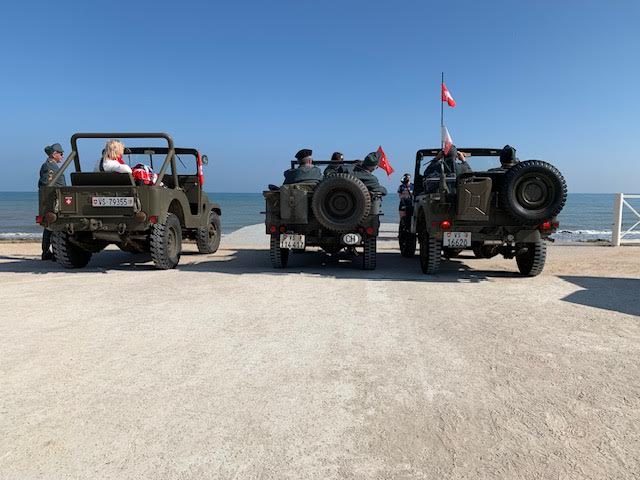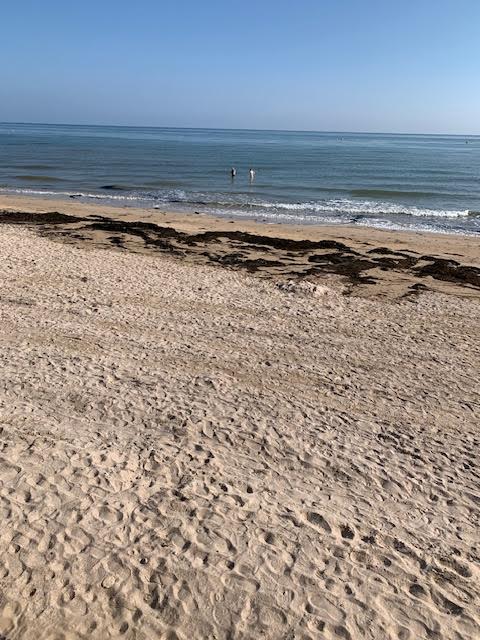 Abraham Lincoln
If given the truth, the people can be depended upon to meet any national crisis...
Abraham Lincoln
If given the truth, the people can be depended upon to meet any national crisis...
 Guildford news...
for Guildford people, brought to you by Guildford reporters - Guildford's own news service
Guildford news...
for Guildford people, brought to you by Guildford reporters - Guildford's own news service
Dragon Reader Reports from Normandy – Eighty Years On
Published on: 7 Jun, 2024
Updated on: 9 Jun, 2024
By John Pletts
It is difficult to believe that this seaside strip of chic cafes, attractive flats and houses, today under a clear blue sky, should have been so totally different in June 1944.
Fifty miles of mechanised warfare, of deafening noise, of death and destruction were unleashed that June morning. The price of liberation from tyranny.
Today, though, is like a giant re-enactment event. The place is thronged with khaki Jeeps, other ancient military vehicles and even amphibious “Ducks” [DUKWs]. And gaily dressed, happy people. And ex-soldiers proudly wearing their medals.

One of the static Spitfires on display. Spitfires were used by the RAF throughout the war and helped provide complete air superiority on D-Day.

Memorial featuring William Millin, commonly known as Piper Bill. Lord Lovat, commander of the British 1 Special Service Brigade, ordered him to play his troops ashore.
There are even at least three Spitfires in static displays. It seems that the further Operation Overlord slips into the past the greater are the celebrations. Which is good. So the roads are full of old Jeeps, old motorbikes and modern motorbikes and lots of blue police motorbikes, cars of course and bicycles including mine.
My bicycle is a good way to get around except that many of the roads around Vers sur Mer are ‘barred’, awaiting the arrival of various heads of state for remembrance celebrations.
There are official events all along this coast. The mayor speaks and the people listen.
Explanatory plaques proliferate to explain what happened here eighty years ago. Yet go inland a few kilometres and one finds peaceful France, full of stone houses which would be worth millions if they were in south east England.
Setting out this morning from Ouistreham to the east I have passed Sword and Juno beaches, the latter celebrated as the Canadian beach. Gold Beach is currently inaccessible.
Bloody Omaha is to the west. There the American troops had to contend with entrenched German strongpoints, cliffs and amphibious tanks which malfunctioned. It’s a miracle that they advanced at all. One wonders why Omaha Beach was selected as a landing site. Furthest west is Utah Beach.
It’s a pity that generally our young people do not take more interest in World War 2. It is seen as a just war. There was only one country that was continuously engaged from the start in September 1939 until the end in August 1945. That country was Great Britain. Shouldn’t we be justly proud of our part in it ?
Responses to Dragon Reader Reports from Normandy – Eighty Years On
Leave a Comment Cancel reply
Please see our comments policy. All comments are moderated and may take time to appear. Full names, or at least initial and surname, must be given.
Click on cartoon for Dragon story: Public Asked for Views on SCC’s Proposal for Reduced Speed Limits


Recent Articles
- Witness Appeal Following Fatal Collision
- Celebration at Guildford Cathedral of its Latest and Future Church Leaders
- Photo Feature: Now You See It…
- Letter: Snail-paced Progress for Full Weir Repair
- Mayor’s Diary: July 5 -July 20
- One Homeowner Recompensed but Fight Continues Over Waverley CIL Charges
- Letter: Fine Those Guilty of Anti Social Behaviour
- GBC Working Hard To Mitigate Looming Weyside Urban Village Deficit
- Letter: Rapist Also Spearheaded Vicious Campaign Against the PCC
- Notice: Guildford Festival of the Arts – September 2025


Recent Comments
- Jan Messinger on Public Asked for Views on SCC’s Proposal for Reduced Speed Limits
- Fiona White on GBC Asks Residents for Views on Its Draft Building Height Guidance
- Dave Middleton on Letter: Fine Those Guilty of Anti Social Behaviour
- Carina Coverly on GBC Asks Residents for Views on Its Draft Building Height Guidance
- M Durant on Online Event Will ‘Help Residents Have Their Say On Local Government Reorganisation’
- Jim Allen on GBC Working Hard To Mitigate Looming Weyside Urban Village Deficit
Search in Site
Media Gallery
Dragon Interview: Local Artist Leaves Her Mark At One of England’s Most Historic Buildings
January 21, 2023 / No Comment / Read MoreDragon Interview: Lib Dem Planning Chair: ‘Current Policy Doesn’t Work for Local People’
January 19, 2023 / No Comment / Read MoreA3 Tunnel in Guildford ‘Necessary’ for New Homes, Says Guildford’s MP
January 10, 2023 / No Comment / Read More‘Madness’ for London Road Scheme to Go Ahead Against ‘Huge Opposition’, Says SCC Leader
January 6, 2023 / No Comment / Read MoreCouncillor’s Son Starts Campaign for More Consultation on North Street Plan
December 30, 2022 / No Comment / Read MoreCounty Council Climbs Down Over London Road Works – Further ‘Engagement’ Period Announced
December 14, 2022 / No Comment / Read MoreDragon Interview: GBC Reaction to the Government’s Expected Decision to Relax Housing Targets
December 7, 2022 / No Comment / Read MoreHow Can Our Town Centre Businesses Recover? Watch the Shop Front Debate
May 18, 2020 / No Comment / Read More









Frank Phillipson
June 7, 2024 at 10:08 pm
Just to correct the point stating that the “amphibious tanks” (Sherman Duplex Drive (DD) tanks) – “malfunctioned” on Omaha beach.
On that beach they were launched from their landing craft too far out (approximately three miles out). Additionally, these landing craft were drifting away from the target beach which forced tanks launched from them to set a course which put them side-on to high waves.
Finally, the very choppy conditions following a storm (6 ft high waves when these tanks were operationally designed for 1 ft waves) led to the majority of these tanks sinking. The loss of these tanks was a major contribution to the chaos that then followed on Omaha.
Amphibious tanks on other beaches were launched closer to the shore and made it onto the beach where they contributed by suppresing or knocking out enemy positions.
Nigel Keane
June 8, 2024 at 1:02 pm
The Canadians on Juno Beach had the advantage of sappers in their Armoured Vehicle Royal Engineers (or AVREs) helping to get them off the beaches. Indeed where the Royal Engineers went the infantry and armoured regiments followed all the way into Germany, after all someone has to build the bridges first.
I salute them all.